Peri-implantitis is a damaging inflammatory process which affects both the hard and soft tissues surrounding a dental implant. The soft tissue will become swollen and inflamed and the alveolar bone, which surrounds and supports the dental implant for the purposes of stability, is diminished over time.
The bone loss with peri-implantitis makes this disease more damaging than peri-mucositis, which is a reversible inflammatory reaction involving just the soft tissue around the implant.
The Signs and Symptoms of Peri-Implant Diseases
Peri-implantitis does not appear the same for everyone. It is suggested that you continue to schedule your regular dental checkups and to seek advice from your dentist if you have concerns.
For starters, it should be established that healthy peri-implant tissue should not be inflamed, swollen, bleeding, producing pus, or looking red in appearance.
From your point of view, you may notice a loosening or even a wobbling of your implant. This symptom is evident with a more advanced stage of peri-implantitis, because now the implant fusion and integration into the jawbone is being compromised. It is likely you might first notice bleeding while you are brushing your teeth. You may also notice some swelling around the implant, and you have bad breath or a foul taste now present in your mouth.
From a clinical perspective, peri-implantitis includes both the inflammation of soft tissue and the damage to the jawbone, which is identified with an x-ray and when bleeding occurs with nearby tissue probing, which is a common sign for soft tissue inflammation. On some rare occasions you may have bone loss without any signs of soft tissue inflammation. If there is no evidence of bone loss, then the diagnosis is peri-mucositis disease.
Other symptoms may include pain and gingival hyperplasia. Pain is a rare symptom and is usually associated with an acute infection.
Symptoms most often identified by your dentist:
- Bleeding and even the discharge of pus with soft tissue probing.
- Swelling and inflammation.
- Sagging pocket formation or gum recession.
- A change in color from a healthy pink to redness.
- Hyperplasia.
- X-ray evidence of bone mass loss around implant.
Signs most often identified by you:
- Bleeding when brushing your teeth.
- You can feel swelling around your implant.
- A constant foul taste in your mouth.
- Annoying bad breath.
- A loose or wobbly implant.
- Discomfort or unusual pain.
Prevention of Peri Implant Diseases
If peri-implant mucositis is identified, it should be treated promptly to avoid the progression to peri-implantitis, for which there are no simple and easy treatments to reverse it.
You should practice simple plaque removal daily to prevent or treat peri-implant mucositis with toothbrushing. Your dentist will provide oral hygiene instructions to ensure you are removing plaque sufficiently. The risk of an implant disease is significantly higher if you smoke. You might consider quitting smoking to achieve the best results.
Your dentist will qualify factors to ensure that the elements of your implant are the correct size to avoid creating additional problems. They will monitor the margins of the restoration placement to remove any extruded cement during the crown placement. After your implant placement, your dentist will carefully and regularly monitor the health of your implant at your regular checkups.
